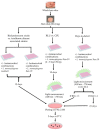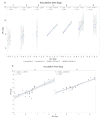Non-Destructive Luminescence-Based Screening Tool for Listeria monocytogenes Growth on Ham
- PMID: 33233500
- PMCID: PMC7699547
- DOI: 10.3390/foods9111700
Non-Destructive Luminescence-Based Screening Tool for Listeria monocytogenes Growth on Ham
Abstract
Listeria monocytogenes is a food-borne pathogen often associated with ready-to-eat (RTE) food products. Many antimicrobial compounds have been evaluated in RTE meats. However, the search for optimum antimicrobial treatments is ongoing. The present study developed a rapid, non-destructive preliminary screening tool for large-scale evaluation of antimicrobials utilizing a bioluminescent L. monocytogenes with a model meat system. Miniature hams were produced, surface treated with antimicrobials nisin (at 0-100 ppm) and potassium lactate sodium diacetate (at 0-3.5%) and inoculated with bioluminescent L. monocytogenes. A strong correlation (r = 0.91) was found between log scale relative light units (log RLU, ranging from 0.00 to 3.35) read directly from the ham surface and endpoint enumeration on selective agar (log colony forming units (CFU)/g, ranging from 4.7 to 8.3) when the hams were inoculated with 6 log CFU/g, treated with antimicrobials, and L. monocytogenes were allowed to grow over a 12 d refrigerated shelf life at 4 °C. Then, a threshold of 1 log RLU emitted from a ham surface was determined to separate antimicrobial treatments that allowed more than 2 log CFU/g growth of L. monocytogenes (from 6 log CFU/g inoculation to 8 log CFU/g after 12 d). The proposed threshold was utilized in a luminescent screening of antimicrobials with days-to-detect growth monitoring of luminescent L. monocytogenes. Significantly different (p < 0.05) plate counts were found in antimicrobial treated hams that had reached a 1 log RLU increase (8.1-8.5 log(CFU/g)) and the hams that did not reach the proposed light threshold (5.3-7.5 log(CFU/g)). This confirms the potential use of the proposed light threshold as a qualitative tool to screen antimicrobials with less than or greater than a 2 log CFU/g increase. This screening tool can be used to prioritize novel antimicrobials targeting L. monocytogenes, alone or in combination, for future validation.
Keywords: Listeria monocytogenes; antimicrobial; ham; luminescence; ready-to-eat meat products.
Conflict of interest statement
The authors declare that they have no known competing financial interests or personal relationships that could have appeared to influence the work reported in this study.
Figures





Similar articles
-
Viability of Listeria monocytogenes on Boneless, Water-Added Hams, Commercially Prepared with and without Food-Grade Chemicals, during Extended Storage at 4 and/or -2.2°C.J Food Prot. 2016 Apr;79(4):613-9. doi: 10.4315/0362-028X.JFP-15-431. J Food Prot. 2016. PMID: 27052866
-
Viability of Listeria monocytogenes on commercially-prepared hams surface treated with acidic calcium sulfate and lauric arginate and stored at 4°C.Meat Sci. 2005 Sep;71(1):92-9. doi: 10.1016/j.meatsci.2005.04.006. Epub 2005 Jun 28. Meat Sci. 2005. PMID: 22064055
-
Effect of Pressure, Reconstituted RTE Meat Microbiota, and Antimicrobials on Survival and Post-pressure Growth of Listeria monocytogenes on Ham.Front Microbiol. 2018 Aug 27;9:1979. doi: 10.3389/fmicb.2018.01979. eCollection 2018. Front Microbiol. 2018. PMID: 30210467 Free PMC article.
-
Prevalence and growth potential of Listeria monocytogenes in innovative, pre-packed, plant-based ready-to-eat food products on the Belgian market.Int J Food Microbiol. 2024 Jan 30;410:110506. doi: 10.1016/j.ijfoodmicro.2023.110506. Epub 2023 Nov 25. Int J Food Microbiol. 2024. PMID: 38043378 Review.
-
Prevalence and challenge tests of Listeria monocytogenes in Belgian produced and retailed mayonnaise-based deli-salads, cooked meat products and smoked fish between 2005 and 2007.Int J Food Microbiol. 2009 Jul 31;133(1-2):94-104. doi: 10.1016/j.ijfoodmicro.2009.05.002. Epub 2009 May 9. Int J Food Microbiol. 2009. PMID: 19515447 Review.
Cited by
-
Determination of Nisin Concentration to Control Listeria monocytogenes in Cooked Ham.Indian J Microbiol. 2024 Dec;64(4):1664-1671. doi: 10.1007/s12088-024-01208-7. Epub 2024 Feb 17. Indian J Microbiol. 2024. PMID: 39678960
References
-
- CDC Outbreak of Listeria Infections Linked to Deli-Sliced Meats and Cheeses | Outbreak of Listeria Infections Linked to Deli-Sliced Products | April 2019 | Listeria | CDC. [(accessed on 5 October 2020)]; Available online: https://www.cdc.gov/listeria/outbreaks/deliproducts-04-19/index.html.
LinkOut - more resources
Full Text Sources

